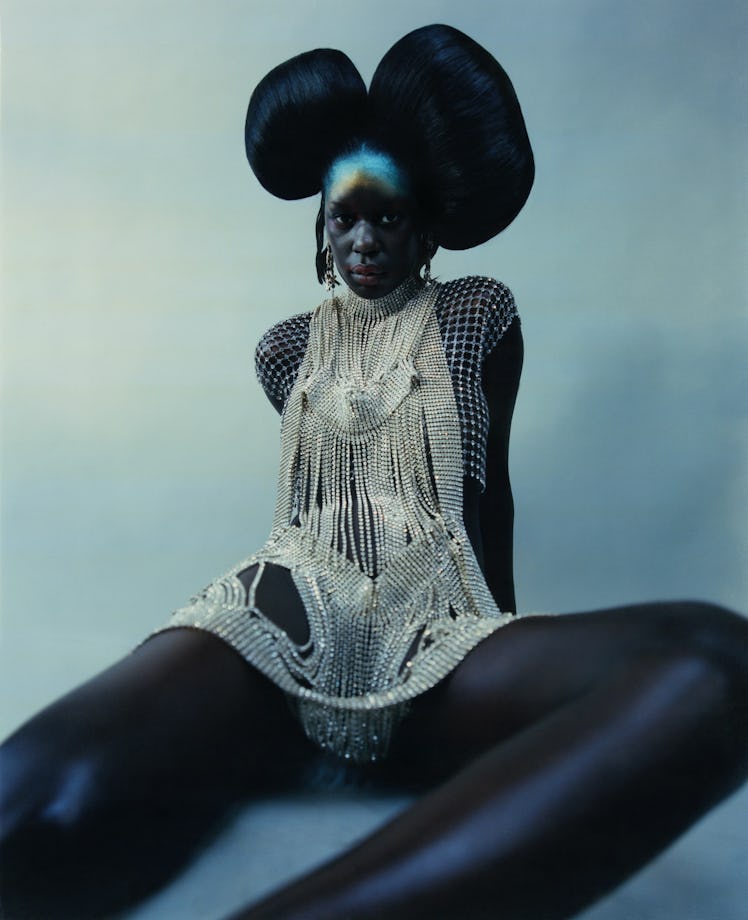When W approached Cyndia Harvey to conjure up a project for the magazine, the London-based hairstylist was more than ready. “I had wanted to capture the essence of Black women for a long time, in a way that hadn’t been done before,” she says, adding that she was particularly inspired by the iconic paintings of the British artist Chris Ofili. “His work makes me so happy, because it celebrates the Black female body in a way that is quite seductive and poetic, but not objectified or sexualized. The proportions, the fluid shapes, and the scale of Ofili’s figures are so interesting—and often, the hair is almost as big as the body.”
Harvey, 33, was born in St. Ann, Jamaica, and as a child she would while away hours after school in her mother’s hair salon. “It was a bottomless well of creativity,” she says. “Women didn’t just come in for a simple wash and blow-dry; everything was ceremonial. Hairstyles were bold, intricate, and created to last. The process was mesmerizing.” When she was 11, Harvey moved to southeast London to live with an aunt, something she describes as “strange but not uncommon” for many immigrant children. Even at such a young age, she knew the move was a “big opportunity” she didn’t want to miss.
Eventually, she enrolled in Croydon College to study art, but after a year she transitioned into hairstyling, working on music videos and magazine photo shoots until she landed a permanent gig assisting the celebrated hairstylist Sam McKnight. She stayed with him for six years before branching out on her own, landing clients that now include Gucci, Louis Vuitton, and Burberry, as well as creative powerhouses such as Michaela Coel, the star of the critically lauded series I May Destroy You. Throughout her career, Harvey has made a point of expanding the narrative of diversity and inclusion in her field. In 2016, together with the filmmaker Akinola Davis Jr., Harvey made a short film titled This Hair of Mine, which explores “lineage, tradition, and how hairstyles connect us to our ancestral past,” she says, adding that plans are afoot for a new iteration of the project later this year.
Two full days went into creating the sculptural hairdos seen here—and that’s before Harvey even stepped on set with the models and creative team (photographer Harley Weir, stylist Raphael Hirsch and makeup artist Ammy Drammeh) whom she hand-picked for the project. “It’s a lot of work figuring out the shapes that work,” she says. “But of course, there’s the magic that happens during the shoot. I get loads of inspiration when the girl is in my chair and I’m chatting with her, observing her disposition, her body language, her personality.” Harvey wanted her striking styles to work with all shapes and sizes—so much so that she brought a prosthetic pregnancy belly to the shoot. “A short afro is beautiful, but that seems to be all people think you can do with Afro hair—they don’t really push it,” she says. “You never see the same fantasy element when it comes to Black models that you do with other fashion images; it’s just not there. So achieving that was a huge part of this shoot. I wanted Black hair to be part of a fantasy.”
Adeyemi wears a vintage top from the Arc London; Susan Caplan earrings; Pebble London necklace (worn as belt).
Hair by Cyndia Harvey at Art Partner; makeup by Ammy Drammeh for MAC Cosmetics at Bryant Artists. Models: Keisha Asare, Destiny Adeyemi, Sade Alexis; Nyagua Ruea at Milk Management; Jay Jay Bol at Wilhelmina London; Sebrina Auma at D1 London. Casting by Julia Lange at Artistry. Set design by Afra Zamara at East Co. Produced by Joy Hart at Partner Films; production coordinator: Nerea Wallis; photo assistants: Alexa Horgan, Shahram Saadat, Pedro Faria; retouching: Upper Studio London; fashion assistant: Archie Grant; hair assistants: Pal Berdahl, Kanae Kikuchi, Sharon Robinson; makeup assistant: Elise Priestley; casting assistant: Lisa Müller; set assistant: Bianca Trombi.
